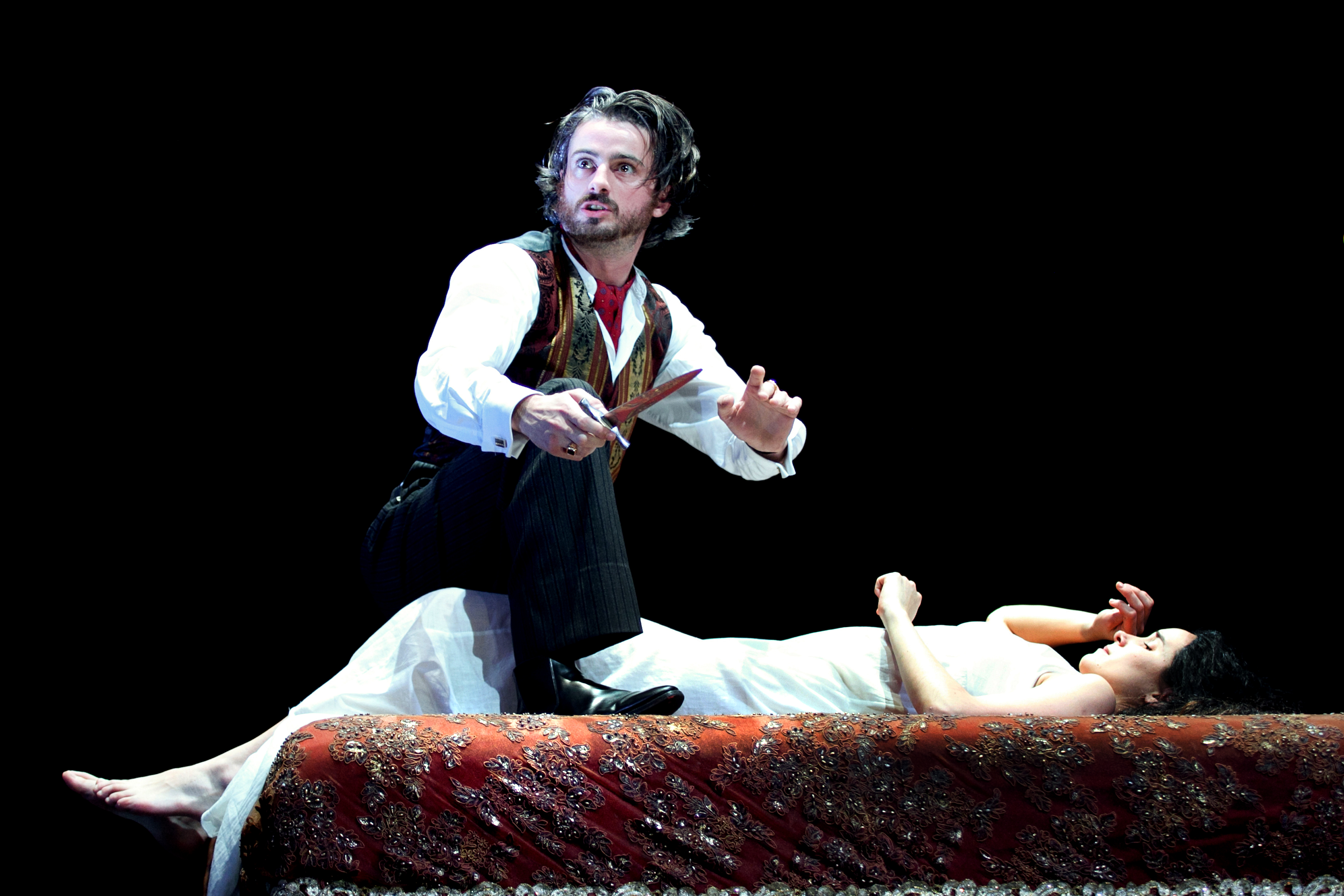
November 4, 2015, by Peter Kirwan
The Duchess of Malfi @ Nottingham Playhouse
This is a repost of a review originally submitted to Exeunt Magazine.
To the sound of seagulls and a ship’s horn, assorted servants, ladies, nobles and clergy from a range of time periods start criss-crossing the stage, piling up luggage and making preparations. Fiona Buffini’s new production of Webster’s tragedy for Nottingham Playhouse begins in a flurry of motion that pervades the play, propelled by strong performances towards a spectacular and bloody finale. It’s a pacey and clear production that, while from perfect, gives a strong account of the play’s central narrative.
Neil Murray’s design is sumptuous. Large curtains hang from the eaves, a chandelier and candelabras light the stage, and an enormous ornate door towers upstage. The Cardinal’s lodgings are a dazzling red, and large drapes cast shadows in which Matthew Wait’s Bosola can linger. In her previous Playhouse productions Buffini has established her love for tricks of light that allow mirrors and fabrics to become suddenly translucent, revealing characters behind them. For a play that turns on surveillance this is enormously effective; as the secretly married Antonio and Duchess part for a moment, Ferdinand is suddenly revealed to be standing watching them from behind a previously solid standing mirror. Later, the dead Duchess appears in similar vein behind Antonio to deliver the lines of her Echo in one of the production’s strongest scenes, emphasising the warnings of her offstage voice.
The production suffers, however, from disjointed transitions that disrupt fluidity. Buffini seems to want to evoke the continuous staging of early modern theatre while also having climactic full stops to every scene, marked by blackouts. The stop-start feel is frustrating, and actors seem hesitant about how to get offstage, often simply turning awkwardly and walking out. When this hesitation happens in the middle of key action – such as the Duchess discovering the hand, or Ferdinand suddenly rising to stab Bosola – the effect is comically bathetic.
The central story is played strongly. Beatriz Romilly’s Duchess is surprisingly girlish, wearing a light green dress and a garland of jewelled flowers set atop an enormous bush of hair. Her flirtation with Jamie Satterthwaite’s Antonio is playful, she teasing him while he fumbles and kneels. Yet her apparent giddiness is anything but, and her commanding tone against her brothers and Bosola demonstrates her authority. At the start of the second half she is revealed alone in a dark prison with hair shorn, and the production begins its brutal torture. The murderers drag Lisa Howard’s Cariola by her hair and (unconvincingly) snap her neck, and tie ropes around the Duchess’s neck which they pull from opposite ends of the stage until she crumples. Romilly’s dignity throughout is impressive, though rather cruelly undermined as she thrashes in pain.
While the production doesn’t shy away from staging the brutality against its women, however, it matches it with the fates of the men. Chris Jared is an excellent and unpredictable Ferdinand, whose hangers-on cannot judge their master’s mood from minute to minute. The bond he forms with Bosola, the only man not to flatter him, is oddly touching, and as Ferdinand berates Bosola for carrying out the murder he himself ordered, this unhealthy relationship becomes central. While Bosola becomes more intensely self-purposed, Ferdinand descends into twitching neurosis. By the time he is being treated for lycanthropia, he leaps onto the doctor and bites chunks out of his back. This then feeds into the final confrontation. Bosola has already stabbed Patrick Brennan’s Cardinal, who has stripped down to his underwear, when Ferdinand enters and, instead of helping his brother, begins licking his blood and eating flesh until Bosola stabs him. The fascinating, sickening image of church and state reduced to two near-naked men consuming one another on a bright red bed makes this the climax of a much broader revenge fantasy against an oppressive patriarchy than Bosola’s own.
At times the production doesn’t seem to know quite what to do with other scenes. The madmen wander onstage, sing a song and then wander off again, with no effect on the action. Peter Bray’s Delio and Jim Findley’s Castruccio retain fragments of their plots that distract from the main narrative but receive no real attention. Yet Rebecca Sarker as Julia distinguishes herself with a fittingly melodramatic performance: sashaying around the stage to torment her suitors, holding Bosola at gunpoint for the crime of making her love him, and finally dying spectacularly after kissing a poisoned bible.
While shaky in places, Buffini’s vision of a corrupt world self-destructing is compelling. Stressing the play’s crimes against women, and giving no quarter to her persecutors, Buffini ensures that the revenge, at least, is satisfying.
Photograph courtesy of Nottingham Playhouse, by Sheila Burnett.
No comments yet, fill out a comment to be the first

Leave a Reply